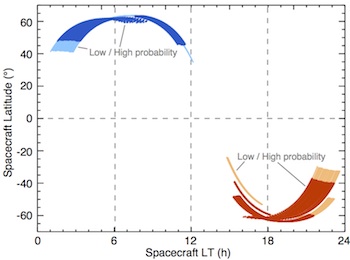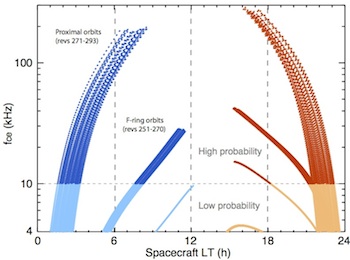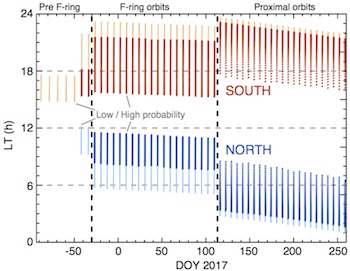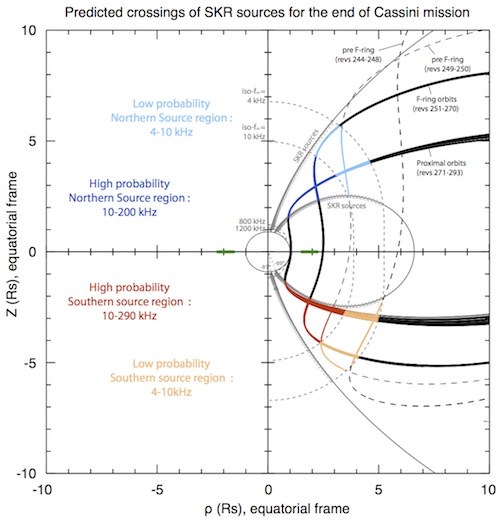
Cassini/RPWS/HFR-Kronos
Access to Lesia-Meudon data products
In situ Cassini Measurements Within Auroral Regions
In situ Cassini measurements within auroral regions
The end of the Cassini mission will sample high latitudes and distances close enough to measure in situ the auroral regions (i) where Saturn Kilometric Radiation (SKR) is produced and (ii) where acceleration processes are suspected to reside, similarly to the terrestrial case.
So far, SKR sources were traversed only once, possibly twice, by Cassini in 2008, at unusually large distances (f ~ 10kHz) and rather on the nightside. At this occasion, a series of case studies analyzed in details the wave and auroral plasma properties (Lamy et al., 2010, Mutel et al., 2010, Bunce et al., 2010, Schippers et al., 2011, Lamy et al., 2011, Kurth et al., 2011, Menietti et al., 2011). The 2016-2017 interval will provide measurements much closer to the planet (sampling more intense radio sources) for a variety of Local Time sectors.
The data access section provides a list of intervals along Cassini’s trajectory (retrieved form the University of Iowa ephemeris webpage) where SKR sources are predicted to be crossed (see details below) in 2016 and 2016, including proximal, F-ring and pre F-ring orbital sequences.
Simulations of radio sources
SKR is driven by a wave-electron cyclotron resonance at frequencies close to the local electron gyrofrequency fce. It is straitghforward to simulate SKR sources along the Cassini’s trajectory with a magnetic field model, as done in past modeling studies (Lamy et al., 2008, 2013). For this purpose, we use the SPV magnetic field model (Davis and Smith, 1990) together with a simple model of current sheet derived from Voyager 2 (Connerney et al., 1983). We then assume SKR emission at fce over a typical frequency range, from 4 to 1200kHz. As the SKR spectrum is highly variable, radio sources over [10,800kHz] are considered to have a high probability to be active, while emission over [4,10kHz] and [800,1200kHz] is considered to have a low probability. SKR sources are then distributed in northern and southern hemispheres along magnetic field lines, whose southern footprint maps a circular auroral oval from -69° to -81° latitude. This range was chosen to include the statistical UV auroral oval (Lamy et al., 2009) together with possible high latitude transient emissions (Prangé et al., 2005) or low latitude weaker secondary emission (Grodent et al., 2010).
Nota Bene : the invariant latitudes and apex of field lines arising from the above model significantly differ from the invariant latitudes and L-shell of dipolar magnetic field lines (see Zarka, Queinnec and Crary, 2001, appendix).
Overall, we identify a total 183 possible passes within auroral regions, displayed in Figures 1, 2, 3, and 4, and distributed as follows :
- Proximal orbits (revs 271-293) : 23 high (23 low) probability passes in each hemisphere
- F-ring orbits (revs 251-270) : 20 high (20 low) probability passes in the south and 20 high (20 low) probability passes in the north
- Pre F-ring orbits (revs 244-250) : 2 high (7 low) probability passes in the south and 0 high (2 low) probability passes in the north
- Proximal orbits (revs 271-293) : 23 high (23 low) probability passes in each hemisphere
- F-ring orbits (revs 251-270) : 20 high (20 low) probability passes in the south and 20 high (20 low) probability passes in the north
- Pre F-ring orbits (revs 244-250) : 2 high (7 low) probability passes in the south and 0 high (2 low) probability passes in the north
Data Access
Access to this dataset is provided here.
Figures

Fig. 1. Predicted SKR sources: location as a function of Latitude and Local Time.
[Large PNG](84kB) [High Res PDF](546kB)
[Large PNG](84kB) [High Res PDF](546kB)

Fig. 2. Predicted SKR sources: Local Time and Radio Source emission frequency (fce).
[Large PNG](180kB) [High Res PDF](580kB)
[Large PNG](180kB) [High Res PDF](580kB)

Fig. 3. Predicted SKR sources: Local Time as a function of time.
[Large PNG](182kB) [High Res PDF](445kB)
[Large PNG](182kB) [High Res PDF](445kB)

Fig. 4. Predicted SKR sources location in a meridian plane.
[Large PNG](242kB) [High Res PDF](1.4MB)
[Large PNG](242kB) [High Res PDF](1.4MB)
References
[1] Lamy et al., GRL, 2010. [link]
[2] Mutel et al., GRL, 2010. [link]
[3] Bunce et al, JGR, 2010. [link]
[4] Lamy et al, JGR, 2011. [link]
[5] Schippers et al, JGR, 2011. [link]
[6] Kurth et al, PRE7, 2011. [link]
[7] Menieti et al, JGR, 2011. [link]
[8] Lamy et al, JGR, 2008. [link]
[9] Davis and Smith, JGR, 1990. [link]
[10] Connerney et al, JGR, 1983. [link]
[11] Lamy et al, JGR, 2013. [link]
[12] Lamy et al, JGR, 2009. [link]
[13] Grodent et al, JGR, 2010. [link]
[14] Prangé et al, JGR, 2010. [link]
[15] Zarka et al, PSS, 2001. [link]
[2] Mutel et al., GRL, 2010. [link]
[3] Bunce et al, JGR, 2010. [link]
[4] Lamy et al, JGR, 2011. [link]
[5] Schippers et al, JGR, 2011. [link]
[6] Kurth et al, PRE7, 2011. [link]
[7] Menieti et al, JGR, 2011. [link]
[8] Lamy et al, JGR, 2008. [link]
[9] Davis and Smith, JGR, 1990. [link]
[10] Connerney et al, JGR, 1983. [link]
[11] Lamy et al, JGR, 2013. [link]
[12] Lamy et al, JGR, 2009. [link]
[13] Grodent et al, JGR, 2010. [link]
[14] Prangé et al, JGR, 2010. [link]
[15] Zarka et al, PSS, 2001. [link]